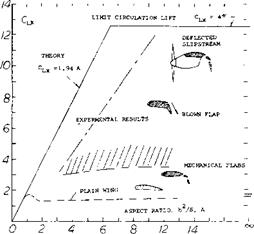THEORETICAL AND DEMONSTRATED LEVELS OF MAXIMUM LIFT
An overview of the theoretical values of maximum lift compared to demonstrated levels is desirable before examining the detailed maximum lift characteristics of single element airfoils and wings.
Theoretical Maximum Lift Coefficient CiX. Theory (1) shows that CLX = 1.94A but can be no greater than 4nr. Thus the Clx of a two-dimensional wing is 4rf. The maximum lift is set by the physical ability of the airfoil to produce circulation. With actual wings and the use of high lift devices the maximum lift coefficient achieved is much less than the theoretical maximum. As shown on figure 1 the maximum lift coefficient demonstrated for a single element airfoil is only 1.5 to 1.6, or 10% of the value theoretically possible. Even with flaps, slats and blowing the demonstrated level of CLy (figure 1) is only approximately 30% of the ideal. The addition of forced circulation brings the demonstrated level of Clx reasonably near
direct thrust
|
Figure 1. Potential maximum lift as a function of aspect ratio- demonstrated and theoretical. |
(1) Maximum Lift
a) Cone, D. D. Theory NASA TN D-657
the ideal. In this case, however, power is required which could have been used directly to supply lift! Basec. on the large spread between the theoretical value and the actual demonstrated values of maximum lift, especially in the case of single element airfoils, it would appear that there is considerable room for improvements of this type.














